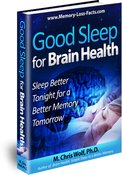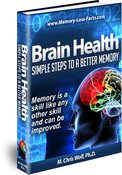Unveiling the Mystery:
Brain Facts
By M. Chris Wolf, PH.D. and Memory Loss Staff
On this page we will discuss important Brain Facts. Throughout the ages, the brain has mystified many people, especially when something is not working correctly in the brain. Historically, people whose brains did not work correctly due to either injury or disease faced being placed, by well-intentioned but ill-informed family members, in insane asylums for treatments as bizarre as the aberrant behavior the interventions they were supposed to treat.
As the field of neuroscience progressed in the 20th century and now into the 21st century, the discoveries of the structure and function of the brain provide those who provide treatment for brain disorders a compendium of brain facts on which to base treatment.
A basic understanding of the structure and function of the brain is essential for those caring for people with brain disorders in order to advocate for their loved one, to understand the process and progression of the brain disorder, and to understand the goals and interventions of treatment.
Improve Memory and Retention Naturally
Get More Info on MemoRise for Improved Memory and Retention
Brain Structure
On the cellular level, the brain is composed of cells called neurons, which are separated by channels referred to as synapses. The neurons send either chemical or electrical signals though the synapses to communicate with each other. The chemicals produced by the neurons are known as neurotransmitters.
During the prenatal period, chemical signals guide the neurons to form various circuits in regions of the brain that control various functions of the body. These brain facts explain why if a person incurs a head injury localized to a specific portion of the brain, the injury manifests as impairment in a specific area such as speech, memory, or motors skills.
Improve Brain Functioning Naturally With Brain Tonic Tissue Salts
Get More Information on Triple Complex Brain Tonic Tissue Salts
Regions and Functions of the Brain
The four major regions of the brain affected by brain diseases include the amygdala, theprefrontal cortex, the anterior cingulate cortex, and the hippocampus. The function of the amygdala is to manage the fear response of the body. This includes the way the individual perceives a situation and the way the person experiences and manifests their fear.
The prefrontal cortex controls higher-level brain functioning such as decision making, solving problems, and making judgment. This region also manages short-term memory and access to long-term memories.
The anterior cingulate cortex controls physical manifestations of emotion, motivation, attention and the modulation of emotional responses. The hippocampus regulates the creation and storage of memories.
The Facts of Behavior Disorders
By examining the brain facts, one can see the relationship between brain dysfunction and behavioral issues. The brain can malfunction as the result of a neurochemical imbalance or damage to the region.
Understanding the facts helps to guide treatment for potential recovery. Both physicians and neuropsychologists have the tools to locate the area of the brain likely causing cognitive, emotional, and behavioral changes.
Reference:
National Institute of Mental Health. (2011). NIMH-Brain Basics. Retrieved July 28, 2011, from National Institute of Mental Health: http://www.nimh.nih.gov/health/brain-basics/brain-basics.shtml
For more information about the brain consider these resources:
Brain: The Complete Mind by Michael S. Sweeney (Author), Richard Restak (Foreword)
The Human Brain Book by Rita Carter, Susan Aldridge, Martyn Page, Steve Parker, and Chris Frith (Collaborator)
Return from Brain Facts to Memory Loss Facts
Our Sponsors



Click Here Now
LIKE THIS SITE?
Interested in having your own internet home based business?





